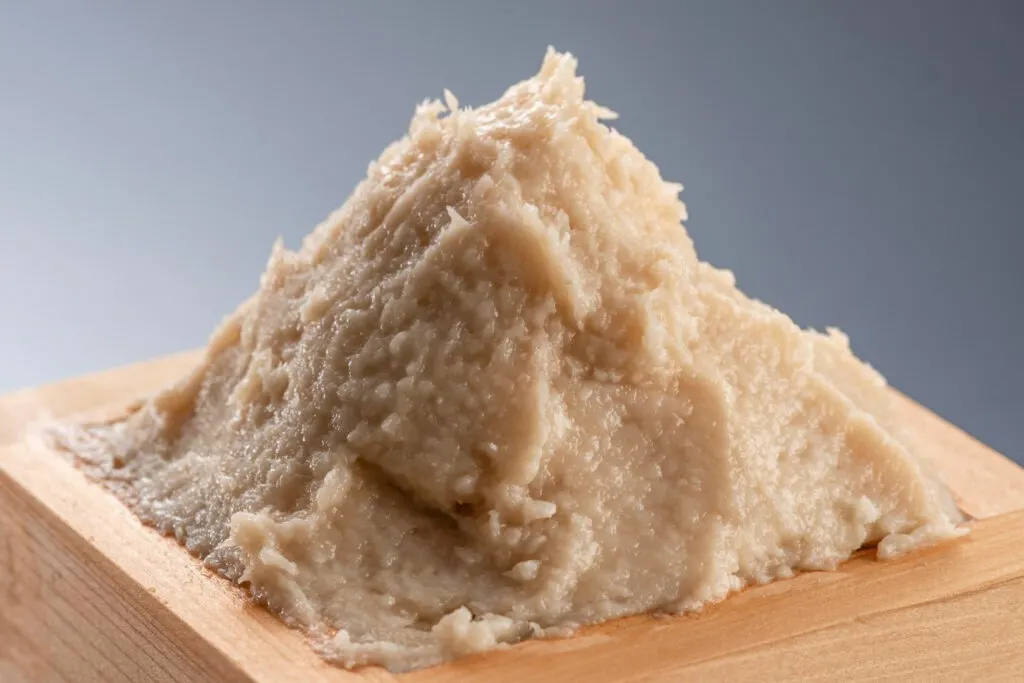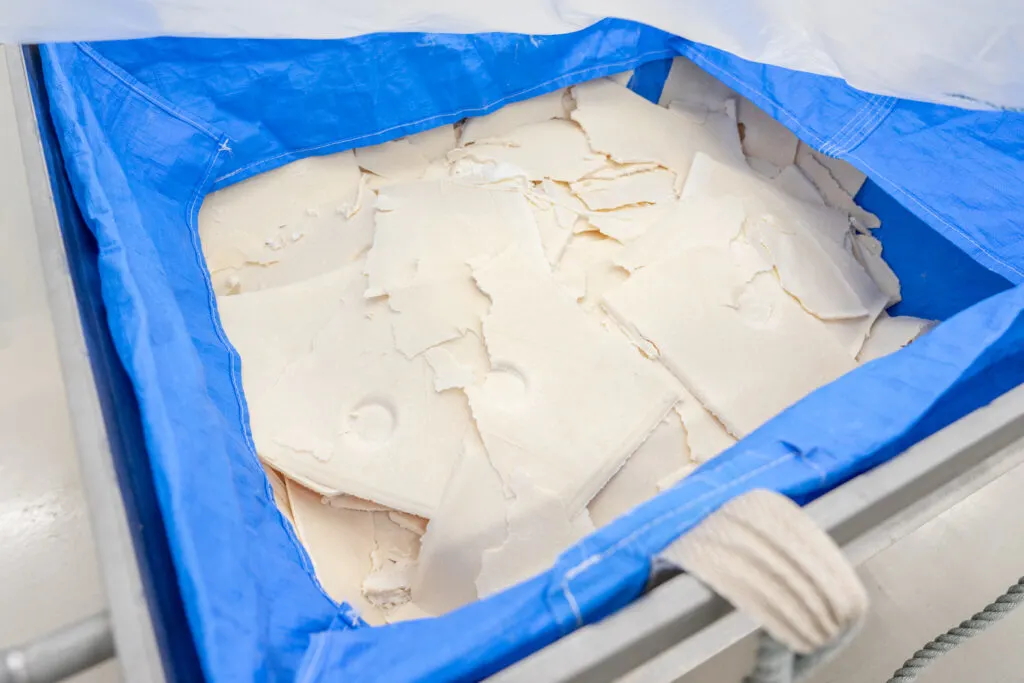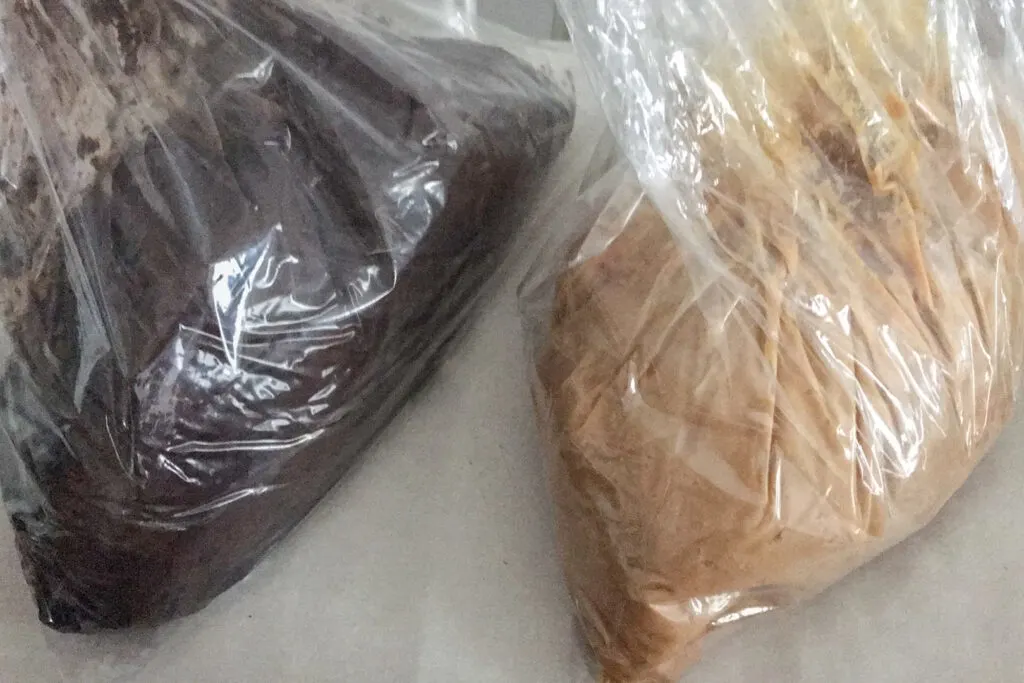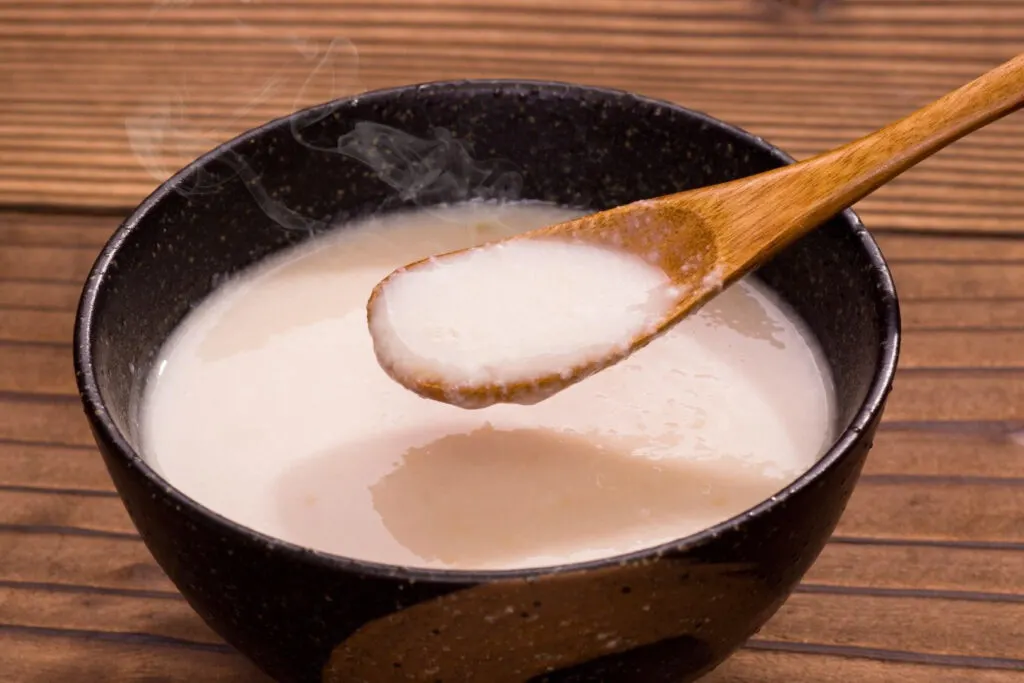Sake Kasu, or sake lees, may not be a familiar ingredient to many people outside Japan.
In fact, even in Japan, its extreme versatility and range of health benefits is largely not fully realized. From savory to sweet dishes and everything in between, there’s a type of sake kasu for just about everyone.
In this article, we’ll explain what sake kasu is, the different types available, and why and how you should use this very special and underutilized ingredient.
Table of Contents
What is Sake Kasu?
Sake Kasu (酒粕, さけかす) is a byproduct of sake, in other words, it’s what’s left over from the sake-making process.
When the sake is pressed out from the fermented mash called Moromi, the pressed rice mash that remains, and accounts for roughly a quarter to one-third of the total weight of the Moromi, is the sake kasu.

Sake has a history of over 2500 years. The first known reference to sake kasu in literature is in an Imperial-ordered text about Japanese laws and customs titled “Engishiki” (延喜式) that dates back to the Heian era (905-927).
Despite the usefulness of sake kasu being known for centuries, the fact remains that sake kasu is not fully utilized today as the versatile ingredient it is, and sadly some ends up as industrial waste.
It is my hope that more influential Michelin star chefs will use sake kasu on their menus, more bakeries will incorporate it into their offerings, and the population at large will use it more frequently in their daily cuisine.
Benefits of Eating Sake Kasu
When you check the food composition database created by the Ministry of Education, Culture, Sports Science and Technology 2020 (the 8th version), it is placed in the condiments & spices category.
Some people might think that there may not be much nutrition left in it since it’s a byproduct and categorized in this way, but it has a wealth of nutrients. I would like to call it “a perfect nutritional fermented food” instead of just calling it one of the condiments.
Sake is made mostly from rice and water (plus kōji mold and yeast), yet if we compare the nutritional value of 100g of sake kasu to an equivalent serving of plain white table rice, the difference is clear.
Compared to table rice, sake kasu is:
- 6 times higher in protein
- 17 times higher in dietary fiber
- 26 times higher in vitamin B2
- 47 times higher in vitamin B6
One hundred grams of sake kasu contains the same amount of protein as 80g of beef. Also when you check the vitamin B1 amount, which helps relieve fatigue and convert carbohydrates into energy, it’s the equivalent of eating 3 apples.
Here is the full nutritional breakdown:
| Nutrition Facts | Sake Kasu [17053 Seasoning Other sake lees] | Cooked white rice [01088 Paddy rice, polished white rice] |
| Energy (kcal) | 215 kcal | 156 kcal |
| Moisture (g) | 51.1 | 60.0 |
| Carbohydrate (g) | 23.8 | 37.1 |
| Dietary fiber (g) | 5.2 | 0.3 |
| Protein (g) | 14.9 | 2.5 |
| Fat (g) | 1.5 | 0.3 |
| Mineral Sodium (mg) | 5 | 1 |
| Potassium (mg) | 28 | 29 |
| Calcium (mg) | 8 | 3 |
| Magnesium (mg) | 9 | 7 |
| Phosphorus (mg) | 8 | 34 |
| Iron (mg) | 0.8 | 0.1 |
| Zinc (mg) | 2.3 | 0.6 |
| Copper (mg) | 0.39 | 0.1 |
| Vitamin B1 (mg) | 0.03 | 0.02 |
| Vitamin B2 (mg) | 0.26 | 0.01 |
| Niacin (mg) | 2 | 0.2 |
| Folic acid (µg) | 170 | 3 |
| Pantothenic acid (mg) | 0.48 | 0.25 |
| Alcohol (g) | 8.2 | 0 |
The health benefits are also numerous, with scientific studies showing sake kasu is effective in:
- Suppressing elevated cholesterol
- Lowering blood pressure
- Preventing amnesia/improving memory loss
- The inhibition of liver damage
Thanks to an abundance of resistant protein and fermentation enzymes, it also has positive effects on preventing obesity and improving metabolism.
Uses for sake lees
Sake lees can be used in a myriad of ways, in both savory foods and sweets, including for:
- Amazake (a sweet, low-alcohol drink typically consumed warm in the winter)
- Soups and hotpot
- Marinades
- Pickling
- Bread and baked goods
- Ice cream and gelato
As a byproduct of sake production, sake kasu will naturally contain some alcohol, likely around 6 to 8%, so if you can’t or don’t want to consume alcohol, or if you are giving it to a child, you should be careful to cook it well to remove the alcoholic content.
Apart from food, it is often used in beauty and cosmetic products. It’s rich in vitamin B2 which is known for beautifying the skin – you can even make your own DIY sake kasu facial pack! It is also used in feed grain for animals, fertilizer in farming or as ingredients to make shochu and gin.
Sake kasu types by texture
In general, there are three different forms in which sake kasu is sold: in sheets, as a crumble and as a paste. We’ll describe these three forms below. There is sake kasu powder as well, however that involves further processing, and will be described later on.
Itakasu, sheet form
A common type you might see at the supermarket is Itakasu (板粕, いたかす), or sake kasu in sheet form. This is simply pressed sake lees that have been cut into pieces.

This is how it looks right after the sake has been pressed out with the sake lees sticking onto the divider of the pressing machine. Removing it from the divider plates is a process called “Kasu-hagashi” (粕剥がし, かす・はがし).

Many sake breweries use this Yabuta sake pressing and filtering machine. Since the sake can be pressed well using this method, the resulting Itakasu is less moist and harder than the other forms. As you can tell from the picture, Itakasu is white. Usually you need to add warm water and leave it for a few hours or microwave it to make it soft and easy to use.
Barakasu, crumble form
Barakasu (バラ粕, ばらかす) or “crumble” form is made from coarsely crushed Itakasu.
Sometimes it is a result of the sake lees being softer and therefore not being firm enough to form a solid Itakasu sheet or it fell from the pressing machine.

Nerikasu, paste form
Nerikasu (練り粕, ねりかす) is made from either Itakasu or Barakasu. It’s kneaded sake kasu and is a softer paste making it easy to use in cooking.

There is Nerikasu that has been stepped on to expel the air and then left to mature for over 6 months. It is softer and will be browner in color. Another name for Nerikasu is actually “Fumikomikasu” (踏込粕, ふみこみかす) meaning “stepped on” kasu.
Many pickle makers prefer to purchase Nerikasu since it will have more umami flavors and rich amino acids for fermenting. Also due to the remaining kōji spores turning the starch inside the sake kasu to sugar, it will enhance the sweetness.
This picture below is also Nerikasu that has been fermented for 3 years (on the right) and 5 years (on the left).

As you can see, the more it ages, the browner it gets. It looks a lot like miso but it is sweeter and has a matured nose with hints of chocolate. I like to dip dried fruits in the aged sake kasu and put them into my brownies.
Types of Sake Kasu by flavor
It’s extremely difficult to give an accurate number of how many different kinds of sake kasu exist.
We have over 1300 sake breweries in Japan and each sake brewery uses different rice, yeast and pressing styles that all affect the resulting flavor. So if a brewery is making 10 different sakes, that means they can potentially produce 10 different types of sake kasu. And while not all sake breweries divide sake kasu by all sake types, if we multiply that by the number of sake breweries, you can get an indication of just how many variations that could be.
If we are to give a simple answer, however, we can divide them by overall flavor based on the main category of sake that was used to make it, namely Premium or Regular sake.
Premium Ginjō type
This includes Junmai Daiginjō, Junmai Ginjō, Daiginjō and Ginjō, with the resulting sake kasu being more fragrant with a fruity aroma.
When pressing premium sake, less pressure is applied than that for standard type sakes, so premium type sake lees tend to be softer and juicier, especially those from competition level premium sake, which contain more sake and are more moist. I prefer to use this for drinking Amazake so I can enjoy this aroma.
The words Daiginjō or Ginjō are always included somewhere on the packaging so people will know that it’s premium.
Standard non-Ginjō type
This includes Junmai, Tokubetsu Junmai, Honjōzō, Futsū-shu types of sake, resulting in non-aromatic sake kasu.
Oftentimes I see these as Itakasu, which are drier and harder than the premium type. It has umami from rice, particularly the junmai variety, and is recommended for use in cooking.
Most of the time, this standard type does not have any specifics of the type of sake used to create it written on the packaging. However you can search the ingredients for the wording 醸造アルコール (jōzō arukōru) or brewer’s alcohol. This is added in the brewing of honjōzō and futsū-shu types, but not in junmai. As junmai has higher levels of umami, you can use this method to make a decision based on your flavor preference.
Other types of sake kasu
Here are some additional products using sake lees.
Sake kasu powder
This is sake kasu that has been dried at low heat and then grinded into a powder. While regular sake lees contains alcohol, due to the process used to make the powder, the final product does not contain alcohol.
It can be used in the same way as regular sake kasu, but its powder form makes it especially useful for baking.
Super sake kasu
Super sake kasu is fermented with lactic acid bacteria. It has a texture similar to yogurt and has acidity. It is ideal for marinating fish or meat and also for those who don’t like the smell or taste of regular sake kasu – this one does not smell like sake kasu and tastes like yoghurt or sour cream.
It can be used to replace dairy, such as in recipes that call for yoghurt or sour cream in baking, or in a potato salad. It also has the added benefit of preventing hay fever symptoms.
It is made by only one brewery, Kikusui in Niigata, under the product name ‘Sakasuke‘. This is how it looks. On the left is nerikasu paste and on the right is super sake kasu fermented by lactic acid bacteria.

Mirin kasu
While you might not see it on the market as often, a similar product to sake kasu is mirin kasu (味醂粕,みりんかす). Mirin itself is a sweet rice wine often used in cooking and so mirin kasu is also sweet. And since mirin is made with glutinous mochi rice, it is more glutinous and has a crumbly texture.
It has another name, “Kobore Ume” (こぼれ梅, こぼれ・うめ), which resembles plum flower blossoms from the Edo period. If you ever find mirin kasu, it is sweet and delicious.
Traditional Japanese foods using sake kasu
You might be wondering how sake kasu is used in traditional Japanese cuisine. Here are five dishes that feature sake kasu as a key ingredient.
Amazake
There are two types of the sweet fermented rice drink known as Amazake (甘酒, あまざけ). One has a sake kasu base (contains alcohol), while the other one is made from kōji rice or Komekōji (米麹, こめこうじ) and is non-alcoholic.
If you want to make a cup of amazake with sake kasu, it’s very easy. Put 1 cup of water in a pan, heat it and once the water is boiled, add about 1 bite size piece of sake kasu, dissolve it at low heat and add sugar.

Kasujiru
Kasujiru (粕汁, かすじる) is a hearty winter chowder typically made with salmon and vegetables.
In the dashi soup, put daikon radish, carrot, aburaage (deep fried tofu) and konjac. When the vegetables have softened, add the salmon. Once it’s cooked, stir in miso, soy sauce and sake kasu.

Kasuzuke
Kasuzuke (粕漬け, かすづけ) is a Japanese pickled dish using a sake lees marinade. You can use it to pickle various ingredients, such as fish, veggies, meat, cheese, dried fruits and more!
First, make kasudoko (粕床, かすどこ), a marinade mixture of sake kasu, sake, miso, sugar and salt. Then pickle what you want.

Ishikari Nabe
Ishikari Nabe (石狩鍋, いしかり・なべ) is a beloved salmon hotpot dish from the Ishikari district of Hokkaido.
Just like Kasujiru, it is easy to make. Salmon, onion, tofu, Chinese cabbage, crown daisy shungiku (春菊,しゅんぎく) in a kelp-based soup. To the broth add miso and sake kasu. (You might also like to add butter).

Narazuke
Narazuke (奈良漬, ならづけ) is a marinade used for pickling that hails from Nara prefecture. It’s made from sake kasu, mirin kasu, sake, sugar and salt.
This one is only for the patient as it takes four years or more to pickle the ingredients and the Nukadoko (the fermented mash used for pickling) must be changed a number of times along the way. Over time, however, the pickled vegetables and fruits will turn a dark brown color and have a distinctive sweet taste.

Sake kasu in sweets and baking
Sake lees makes fluffy bread and I frequently make my own at home. I used to find sake kasu bread at Dean and Deluca and loved it, but haven’t seen it for a few years now.
If you buy namakasu (生粕, なまかす) or raw sake kasu from a brewery like Inaba Shuzō sake brewery in Ibaraki where the female brewer makes it from unfiltered unpasteurized sake, there will be lots of enzymes and yeast in it, which will make a great bread without adding bread yeast.
Sake kasu bread is an ideal way to incorporate the ingredient into food for children, as they typically do not like the smell or taste of sake lees. You can make sourdough by using sake kasu as a sourdough bread starter too.
Apart from bread, you can make many different baked goods and sweets using sake kasu, such as scones, cheesecake, ice cream, gelato, chiffon cake, brownies, you name it! If you search online, you will find many recipes.
I recommend you to not just use it in a traditional Japanese way, like making amazake, kasujiru or pickles. Please experiment and find your best recipe; it is a wonderful nutritional food which should not be wasted!
Where to buy sake lees
Sake breweries are the best place to purchase sake kasu, but of course you can go to your nearby Japanese supermarket store to purchase it.
There are also sake specialty stores which handle sake kasu or you can always purchase it online.
How to store sake kasu
Sake kasu itself contains alcohol so it can keep for a relatively long time, but it doesn’t mean you can leave it out in the sunlight or keep it in bad condition. It can last for several months if you store it in the refrigerator.
Once you open it, be sure to put it in a ziplock so it won’t dry out and if you are not using it for a while, you can also keep it in the freezer.
If you like a challenge and want to make your own fermented sake kasu, you can do so by keeping it in a dark room at room temperature. This aged sake lees, called Jukusei Kasu (熟成粕,じゅくせい・かす), will typically start looking like miso.
If you keep it in the refrigerator, the color of the sake kasu may not become very dark but if you keep it at room temperature, it will be darker brown by the year.
Pin me for later

Kyoko Nagano is a serial entrepreneur and Michelin star restaurant enthusiast based in Kanagawa. As a Certified sake sommelier, fermented food sommelier, and tofu, inarizushi and soy oil meister, she is an expert on Japanese food and drink.
Kyoko has spent 17 years abroad in 4 countries, and is now on a mission in Japan to support small craft sake breweries and traditional cultural businesses to help them survive.
